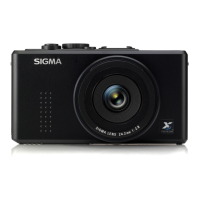Photo-Processing that Delivers the “Wow” Factor
The new “TRUE II”
image-processing engine
The new TRUE II image-processing
engine, specially developed for the
Foveon X3®, was first implemented
in the DP2, to high acclaim. We've
also used it in the DP1x. Applying
our exhaustive knowledge of the
image-creation mechanism of the
direct image sensor, we applied
a proprietary algorithm to do full
justice to its uniquely sophisticated
3-D rendering power, optimizing both
the image-processing time and the in-
camera image processing itself, and
achieving a dramatic improvement in
processing performance.
Having focused our efforts on
optimizing and recording the pure,
rich signal captured by the sensor,
we were determined that the optimal
image quality we had pursued
throughout our development of SLRs
would be fully reproduced throughout
our DP series of compacts-with-a-
big-difference. The rich optical signal
captured by the groundbreaking
direct image sensor needed to be
translated into an information-rich
image. We entrusted that crucial task
to our new, improved TRUE II.
In JPEG mode, images are
finished at Sigma's discretion
JPEG images captured by the DP1x
are photos finished in what Sigma
considers the most appropriate way.
If you find that the photos you take
in JPEG mode look the way you
intended, then by all means enjoy
the ease and convenience of the
JPEG setting. Your JPEG images are
ready to print – just plug the camera
into your printer – and the image
data files are ready to share with
your friends and family. If you want
email-friendly image files that can
be transferred straight from your
camera, JPEG mode wins hands-
down on convenience.
However, when you create a JPEG file,
the data is subjected to irreversible
compression, which leaves very
little scope for image-correction
afterwards. And here's the rub: if
you only shoot JPEG mode, you may
find it very difficult to reproduce the
photo you saw in your mind's eye,
which is your own personal sensory
experience. If you've ever used a
conventional compact digital camera
that only has JPEG mode, you'll know
how unsatisfying the results can be.
Unfortunately, it can be extremely
difficult to fully express your artistic
vision using only JPEG images,
which are created using the camera's
automatic settings.
SIGMA Photo Pro:
the image-processing software that
gets the most out of X3F (RAW) files
The DP1x has an X3F mode (RAW
file format) in which all the image
data captured by the sensor can be
recorded without any significant
deterioration in camera performance.
If you want to do your own hands-on
photo finishing, then for best results,
we recommend SIGMA Photo Pro, the
image-processing software designed
exclusively for these X3F files.
You may think that “RAW data
processing” sounds like something
intimidatingly technical, requiring
high levels of knowledge and skill.
If so, just try SIGMA Photo Pro for
yourself, and you'll soon find out how
easy it really can be. SIGMA Photo
Pro focuses on only those functions
you really need for artistic photo
finishing. Its interface is one of the
most user-friendly and intuitive of
the many RAW data-processing
software packages on the market,
so even if you're a beginner, you'll
find it simple to turn your images
into finished photos. The Adjustment
Controls Palette contains exposure,
contrast, shadows, highlights, color
saturation, sharpness, and the X3 Fill
Light feature. A new noise reduction
control area allows for reduction of
both color noise and luminance noise.
The Color Wheel allows for easy
adjustment of photograph colors.
Simply adjust these parameters and
watch the image change in real time.
That's all it takes to recreate the ideal
photo you had in your mind's eye as
you pressed the shutter.
Sigma's proprietary
X3F file format ensures outstanding
texture and color
In fact, shooting in X3F format has
other advantages too. In a digital
camera, the image signal captured in
RGB is recorded by being converted
into what is known as YCbCr color
space. The Y stands for brightness,
and the CbCr stands for color
difference. In an ordinary digital
camera, a file format known as YCbCr
4:2:2 is used, where the color signal
is set to half the brightness signal.
This format was developed in order
to send color information efficiently
on the limited bandwidth available
20

